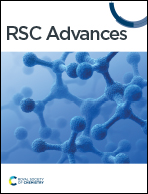Dysoticans F–H: three unprecedented dimeric cadinanes from Dysoxylum parasiticum (Osbeck) Kosterm. stem bark†
Abstract
An asymmetrical true-dimeric cadinane via ketonic bridge [C-15/C-3′], dysotican F (1), two symmetrical pseudo-cadinane dimers through an O-ether linkage [C-3/C-3′], dysoticans G (2) and H (3), as well as three known sesquiterpenoids 4–6 were obtained from the stem bark of Dysoxylum parasiticum (Osbeck) Kosterm. (Meliaceae). Their structures were determined by spectroscopic and quantum chemical calculations of 13C NMR shifts using a GIAO method and electronic circular dichroism (ECD) using a TDDFT method. A possible biogenetic pathway for 1–3 beginning from the known compounds (i–ii) was proposed. Cytotoxic evaluation showed that 2 as a new lead compound is the most potent against the MCF-7 and HeLa cell lines with IC50 values of 12.07 ± 0.17 μM and 9.29 ± 0.33 μM, while 1 has moderate inhibition with IC50 values of 31.59 ± 0.34 μM and 27.93 ± 0.25 μM. Furthermore, 3 is a selective inhibitor against the HeLa cell growth with an IC50 value of 39.72 ± 0.18 μM. A brief structure–activity relationship analysis of all isolated compounds 1–6 was also provided, including comparison with the coexisting molecules in the previous report.



 Please wait while we load your content...
Please wait while we load your content...